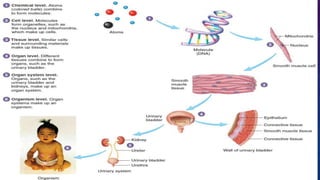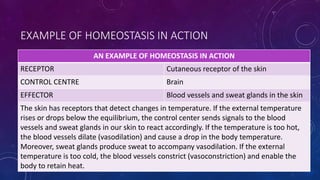TOPIC 1 INTRODUCTION TO PHYSIOLOGY.pptx
- 2. LEARNING OUTCOME At the end of this lecture, students should be able to: • State the definition of physiology, teleological, mechanistic and homeostasis • List different field of physiology • Describe the level of human structural organization • Explains different types of human body systems • Explains the homeostasis regulation and it example.
- 3. WHAT IS PHYSIOLOGY? • Physiology is the science of studying the functional activities and its mechanisms in biological body. • For example: why can heart automatically beat? • Physiology derived from two Greek words: • Physis= nature • Logos= study
- 4. FUNCTION AND PROCESS: TELEOLOGICAL VS MECHANISTIC APPROACH TO SCIENCE Teleological: explains purpose of a physiological process • What is purpose or function? • Why does something exist? • Why does it need to be done? • Example: shivering elevates a low body temperature Mechanistic: explain in terms of cause and effect of physiological process. • What are processes involved? • How does something work? • Example: when body temperature drops below normal, a reflex pathways causes involuntary oscillating skeletal muscle contractions which produce heat.
- 5. DISTINGUISH BETWEEN PROCESS & FUNCTION PROCESS •How do we breath? •How does blood flow? •How do RBCs transport O2? FUNCTION Why do we breath? Why does blood flow? Why do RBCs transport O2?
- 6. FIELD OF PHYSIOLOGY VIRAL PHYSIOLOGY BACTERIAL PHYSIOLOGY CELLULAR PHYSIOLOGY
- 7. FIELD OF PHYSIOLOGY PLANT PHYSIOLOGY HUMAN PHYSIOLOGY
- 8. HUMAN PHYSIOLOGY • In human physiology, we attempt to explain the specific characteristics and mechanisms of human body that make it a living being.
- 9. THE IMPORTANCE OF PHYSIOLOGY • Understanding human body • Diagnosis • Understanding research and applications to practice
- 10. LEVELS OF STRUCTURAL ORGANIZATION
- 12. BODY SYSTEMS • Groups of organs that perform related functions and interact to accomplish a common activity essential for survival of the whole body • Do not act in isolation from one another • Human body has 11 systems.
- 13. CARDIOVASCULAR SYSTEM DEFINITION The heart and the vessels that carry blood or blood constituent (lymph) through the body. FUNCTIONS i. Transport respiratory gases, nutrients, wastes, and hormones ii. Protect against disease and fluid loss iii. Helps regulate body temperature and acid-base balance KEY ORGANS Heart, blood vessels (arteries, veins, and capillaries), and blood.
- 14. DIGESTIVE SYSTEM DEFINITION The body organs that render ingested foods absorbable FUNCTIONS Mechanically and chemically breaks down foods for cellular use and eliminates undigested wastes. KEY ORGANS Mouth, teeth, tongue, oesophagus, stomach, pancreas, liver, small intestine, large intestine (colon), rectum, and anus.
- 15. ENDOCRINE SYSTEM DEFINITION The hormone-producing glands (hypothalamus, pineal gland, pituitary gland, thyroid, parathyroid, thymus, adrenal gland, pancreas, ovaries, testes) FUNCTIONS Controls and integrates body functions via hormones secreted into the bloodstream KEY ORGANS Pituitary gland, thyroid gland, adrenal glands, and pancreas.
- 16. INTEGUMENTARY SYSTEM DEFINITION The integumentary (skin) and structured derived from it (hair, nails and oil sweat glands) FUNCTIONS i. Protects the body ii. Regulates body temperature iii. Eliminates waste iv. Receives certain stimuli (tactile, temperature and pain) KEY ORGANS Skin, hair, and nails.
- 17. LYMPHATIC SYSTEM DEFINITION Consist of the lymphatic vessels, lymph nodes, and other lymphatic organs FUNCTIONS i. Removes foreign substances from blood and lymph ii. Combat disease iii. Maintain tissue fluid balance iv. Absorb dietary fats from the digestive tracts KEY ORGANS Spleen, thymus, tonsils, lymph nodes, and lymphatic vessels.
- 18. MUSCULAR SYSTEM DEFINITION Skeletal muscle of the body and their tendinous attachment FUNCTIONS i. Effects body movements ii. Maintains postures iii. Produces body heat KEY ORGANS Muscles and tendons.
- 19. NERVOUS SYSTEMS DEFINITION Brain, spinal cord, nerves, and sensory organs such as the eye and the ear FUNCTIONS i. Detects and responds to changes internal and external environments ii. Enables reasonings and memory iii. Regulates body activities KEY ORGANS Brain, spinal cord, ganglia, nerves, and sensory organs.
- 20. REPRODUCTIVE SYSTEM DEFINITION The organs that produce, store, and transport reproductive cells (gametes, or sperm and ova) FUNCTIONS Reproduce the organism, produce sex hormones KEY ORGANS Fallopian tubes, uterus, vagina, testes, ductus (vas) deferens, urethra, penis, and prostate.
- 21. RESPIRATORY SYSTEM DEFINITION The body organs concerned with movement or respiratory gases (O2 and CO2) to and from pulmonary blood (the blood within lungs) FUNCTIONS i. supplies oxygen to the blood ii. Eliminates carbon dioxide iii. Helps to regulate acid-base balance KEY ORGANS Mouth, nose, nostrils, sinuses, pharynx, cilia, trachea, larynx, diaphragm, lungs, bronchi, alveoli
- 22. SKELETAL SYSTEM DEFINITION Bones, cartilage and ligaments (which steady the bones at the joints) FUNCTIONS i. Provide body support and protections ii. Permit movement and leverage iii. Produce blood cells (haematopoiesis) iv. Store minerals KEY ORGANS Bones, joints, and ligaments.
- 23. URINARY SYSTEM DEFINITION The organs that operate to remove wastes from the blood and to eliminate urine from the body FUNCTIONS i. Remove various wastes from the blood ii. Regulates the chemical composition, volume and electrolyte balance of the blood iii. Helps maintain the acid-base balance of the body KEY ORGANS Kidneys, ureters, bladder, and urethra.
- 24. ORGAN SYSTEMS INTERRELATIONSHIP • All cells depend on organ systems to meet their survival needs • Organ systems work cooperatively to perform necessary life functions
- 25. HOMEOSTASIS • Homeostasis is a mechanism that maintains a stable internal environment despite the changes present in the external environment. • The body maintains homeostasis by controlling a host of variables ranging from body temperature, blood pH, blood glucose levels to fluid balance, sodium, potassium and calcium ion concentrations.
- 26. HOMEOSTATIC REGULATION • This process of adjustment (called homeostatic regulation) involves: 1. Receptor: which receives information about change in the environment 2. Control centre: which receives and processes information from the receptor 3. Effector: which responds to signals from the control centre by either opposing or enhancing the stimulus.
- 28. EXAMPLE OF HOMEOSTASIS IN ACTION AN EXAMPLE OF HOMEOSTASIS IN ACTION RECEPTOR Cutaneous receptor of the skin CONTROL CENTRE Brain EFFECTOR Blood vessels and sweat glands in the skin The skin has receptors that detect changes in temperature. If the external temperature rises or drops below the equilibrium, the control center sends signals to the blood vessels and sweat glands in our skin to react accordingly. If the temperature is too hot, the blood vessels dilate (vasodilation) and cause a drop in the body temperature. Moreover, sweat glands produce sweat to accompany vasodilation. If the external temperature is too cold, the blood vessels constrict (vasoconstriction) and enable the body to retain heat.
- 29. HOMEOSTASIS BREAKDOWN • The failure of homeostasis function in an internal environment will result in illnesses or diseases. • In severe cases, it can lead to death and disability. • Factors can affect homeostasis: i. Genetics ii. Physical condition iii. Diet and nutrition iv. Venoms and toxins v. Psychological health vi. Side effects of medicines and medical procedure.
- 30. THANK YOU





























